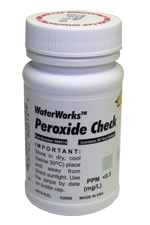Many people use hydrogen peroxide to treat/clean cuts and scratches, but did you know that it also functions as a ‘shock’ treatment in pools and spas? While not used in conjunction with chlorine or bromine, biguanide based sanitizer systems make use of hydrogen peroxide’s strong oxidizing power roughly every other week.
Why is Peroxide Needed
Peroxide works as a shock to the system. Its strong oxidation potential makes it ideal for ‘burning’ organics out of the water that the polymer based sanitizer could not get rid of.
How Can One Test for Peroxide in Swimming Pools?
A good product for testing peroxide levels in swimming pools goes by the commercial name of WaterWorksTM Peroxide Check and has the ability to detect hydrogen peroxide levels as low as 0.5 ppm and as high as 100 ppm.

WaterWorksTM Peroxide Check Test Strips
What is a ‘Safe’ Level of Peroxide in Swimming Pools?
The answer to that question depends on the exact type and brand of biguanide system you use in your pool or spa. We have heard that most biguanide systems recommend hitting and/or reaching a peroxide level of 30 ppm, but we HIGHLY suggest you speak with your local pool and spa dealer, or the company who manufactures the peroxide you use, and ask them. . . just to be sure.




